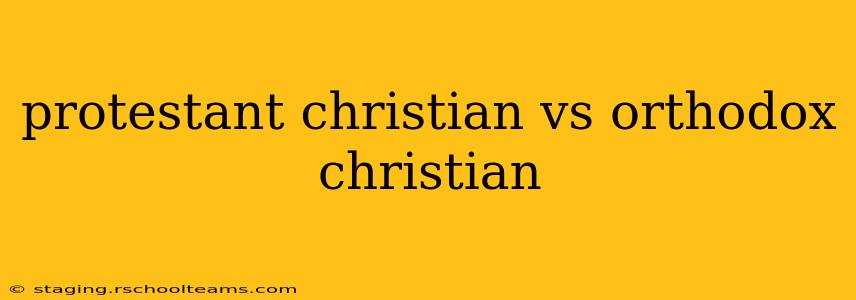Christianity, a faith with billions of adherents worldwide, encompasses a vast tapestry of denominations and traditions. Among the most prominent branches are Protestantism and Eastern Orthodoxy, each boasting unique theological perspectives, liturgical practices, and historical trajectories. This article delves into the core distinctions and shared beliefs between Protestant Christians and Orthodox Christians, offering a nuanced understanding of these significant branches of the faith.
Key Theological Differences:
The chasm between Protestantism and Orthodoxy primarily stems from differing interpretations of scripture and tradition, culminating in significant variations in theological viewpoints.
Authority and Scripture:
-
Protestantism: Emphasizes sola scriptura ("scripture alone") as the ultimate authority for faith and practice. While tradition holds some weight, it's subordinate to the Bible's clear teachings. Different Protestant denominations may interpret scripture differently, leading to diverse theological viewpoints.
-
Orthodoxy: Agrees with the authority of scripture but integrates it with sacred tradition, encompassing the teachings of the early Church Fathers, liturgical practices, and conciliar decisions. Tradition, for Orthodox Christians, is seen as an essential lens through which scripture is understood and applied. This continuous unbroken line of tradition is seen as vital to maintaining the integrity of the faith.
Sacraments:
-
Protestantism: Generally recognizes fewer sacraments than Orthodoxy, often limiting them to Baptism and Communion (the Lord's Supper). The understanding of these sacraments can also vary significantly between Protestant denominations. Some may see them as primarily symbolic, while others maintain a more literal interpretation.
-
Orthodoxy: Recognizes seven sacraments: Baptism, Chrismation (Confirmation), Eucharist (Communion), Confession, Holy Matrimony, Holy Orders, and Anointing of the Sick. These are considered channels of God's grace, not mere symbols. Each sacrament is believed to impart a specific spiritual benefit or blessing.
The Nature of Christ:
While both traditions affirm the divinity and humanity of Jesus Christ, nuances exist in their articulation:
-
Protestantism: Different Protestant denominations hold diverse views on Christology. While the fundamental belief in the dual nature of Christ is common, interpretations vary, sometimes emphasizing one aspect more than the other.
-
Orthodoxy: Maintains a strong emphasis on the hypostatic union, the complete and inseparable unity of the divine and human natures in the single person of Jesus Christ. This is a cornerstone of Orthodox theology and is central to their understanding of salvation.
The Role of the Church:
-
Protestantism: Displays a wide range of views on the church, from the congregational model (individual churches are autonomous) to more hierarchical structures. The concept of the "invisible church," encompassing all true believers, is also emphasized in some Protestant traditions.
-
Orthodoxy: Views the Church as a single, unified body, the "One, Holy, Catholic, and Apostolic Church," with a hierarchical structure headed by the Patriarchs and Bishops. Membership in this visible Church is seen as essential for salvation.
Similarities:
Despite their differences, Protestant and Orthodox Christians share fundamental beliefs:
- Belief in the Trinity: Both affirm the belief in one God existing in three persons: Father, Son (Jesus Christ), and Holy Spirit.
- The Bible as the Word of God: Both acknowledge the Bible as the inspired Word of God, although their approach to interpreting and applying it differs.
- Salvation through Christ: Both believe that salvation is achieved through faith in Jesus Christ and his sacrificial death on the cross.
- The Importance of Prayer: Both traditions place high value on personal and corporate prayer.
Conclusion:
The distinctions between Protestant and Orthodox Christianity are significant and rooted in historical events and differing theological interpretations. While their approaches to scripture, sacraments, and church structure vary, both traditions share a common foundation in their faith in Jesus Christ and the core tenets of Christian belief. Understanding these similarities and differences is vital for fostering interfaith dialogue and promoting mutual respect within the broader Christian community. Further research into specific denominations within both Protestantism and Orthodoxy will reveal even more nuanced perspectives and practices.
